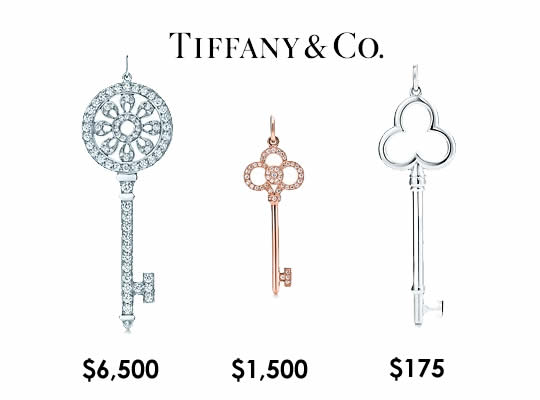Balancing Luxury, Tiffany Style
Luxury brands face a difficult challenge: they must be exclusive, and usually expensive, to maintain their elite status. At the same time, a brand that has extremely limited distribution may not be able to acquire or maintain the visibility in the marketplace that makes the product both recognizable and desirable. A brand that is so limited in distribution that few have heard of it fails to create aspirational buyers who dream of owning it, and doesn’t communicate to others the status of those who DO own it. According to J. N. Kapferer and V. Bastien, authors of The Luxury Strategy, one way to create a balance between exclusivity and visibility is with “access products.”
Yesterday, I saw a full page newspaper ad (placed shortly before the celebration of Mother’s Day in the U.S.) for Tiffany Keys, a product of Tiffany & Co., that provided an excellent illustration of this strategy. The ad was largely white space, with an illustration of the key-shaped pendants. A single very short paragraph of text introduced the reader to mystery and excitement of the Tiffany Key line. Extremely brief product descriptions and prices could be found, but only in microscopic type at the bottom of the full-page ad. Even the store location was limited to the words “Austin The Domain” and a phone number, both in the same tiny font. (I suppose the implication is that if you qualify as a Tiffany buyer, you’ll know where they are.)
The purpose of access products, according to Kapferer and Bastien, is twofold. First, they provide an entry-level product for the “future faithful.” Those are the buyers who are unlikely to invest in the top of the line product now, but can be drawn into the brand experience with a less costly (but still high quality) product. Second, an entry-level product can satisfy what the authors call “day trippers” – casual consumers of luxury items and who don’t have strong brand loyalty.
In every case, it’s important to provide the same brand experience – the buyer must be made to feel they are a valued and respected customer whether they are buying at top of the line or the lowest-cost entry-level product. This is key in building brand loyalty and elevating the customer to higher levels of product.
The challenge is to make the entry-level products accessible and visible without cheapening the brand image. If buyers being to perceive that the luxury brand is primarily in the business of selling these comparatively inexpensive products, the brand will lose its luster and luxury status. The marketplace must perceive that the firm’s flagship high end products are indeed vibrant and an important part of the firm’s business. Keeping the high-end products visible (for example, by fashion shows, celebrity use, etc.) allows the firm to offer lower-end products without destroying the brand.
I think Tiffany does a great job with their minimalist ad – just three products are illustrated, one absolute top of the line, one middle of the road, and an entry-level product. Looking at the ad, one would have no idea that a gulf of over $6,000 separates two of the products, and that the least expensive one costs little more than dinner for two at a fancy restaurant. Only careful inspection of the fine print reveals that difference. (Of course, even the $175 price might be considered a bit extravagant for a small silver pendant, but it’s definitely accessible. Indeed, its status as a modest extravagance is part of the product’s cachet. Buyers of the $175 key are buying the iconic blue box far more than they are buying the best silver pendant one can find for that price.)
Kapferer and Bastien note that even Tiffany lost its way some years ago by overemphasizing its less costly products. This branding gaffe began to erode the firm’s luxury image, and the blue box began to lose its status as a symbol of the ultimate in fine jewelry. Tiffany management changed direction to limit geographic and product line expansion, and was able to reverse the negative trend.
One way Tiffany maintains its brand image is by controlling the retail environment for its products. If one saw the same $175 Tiffany key offered at a discount by a dozen department stores, it wouldn’t be the same product. Entry-level customers wouldn’t get the Tiffany retail experience, and they might begin to compare the product with even cheaper alternatives made by others. At that point, a Tiffany key becomes just an overpriced trinket with a fancy label.
For those Neuromarketing readers don’t spend their days promoting luxury brands, there is still much to learn here. Tiffany’s success includes elements that all marketers can study – setting the tone for an entire product line with a highly desirable (even if inaccessible to most buyers) is one. Controlling the customer experience even with the tradeoff of more limited distribution is another.
And, readers, don’t forget – Mother’s day is around the corner!



You make some interesting observations. The challenge of making the entry-level products accessible and visible without cheapening the brand image is a fine line. One I wonder if is crossed just by the availability of high end items on mass marketplaces like Amazon (and yes even Tiffany). Does that association with such a mainstream marketplace lesson the prestige of owning a luxury watch or piece of jewelry, or does it allow those used to extravagances that are feeling a bit tight in the wallet in these tough times maintain their status at a more affordable price.